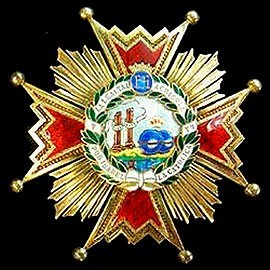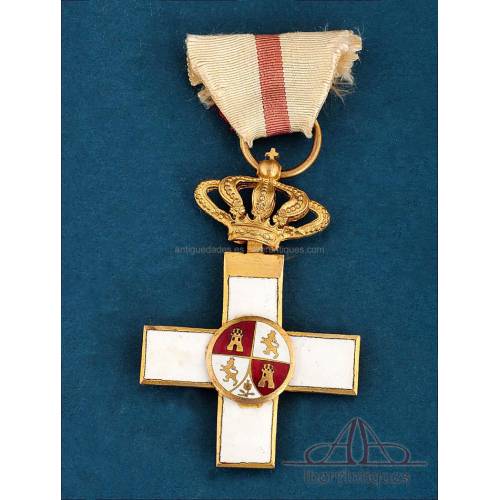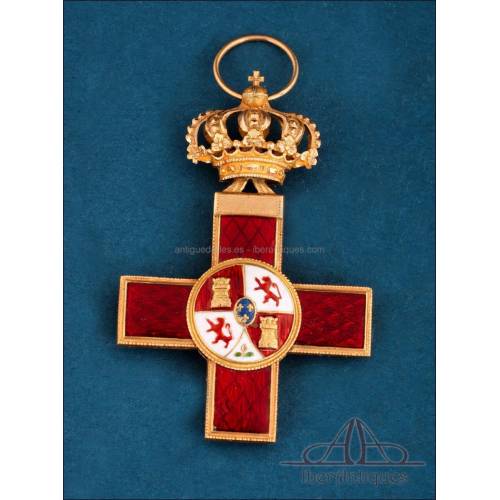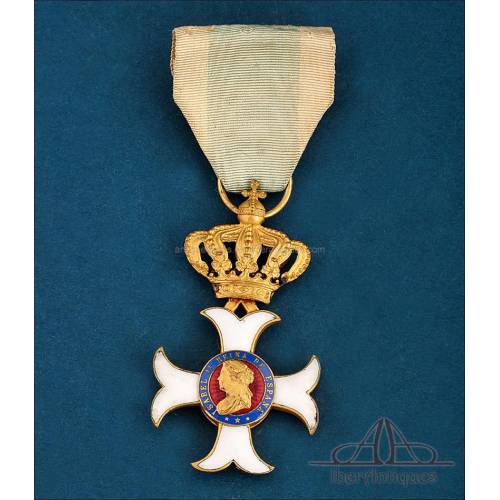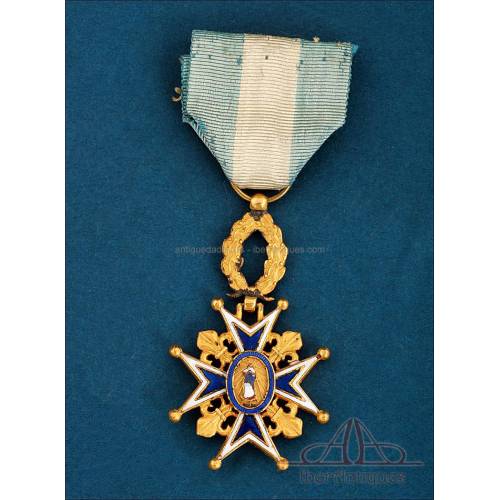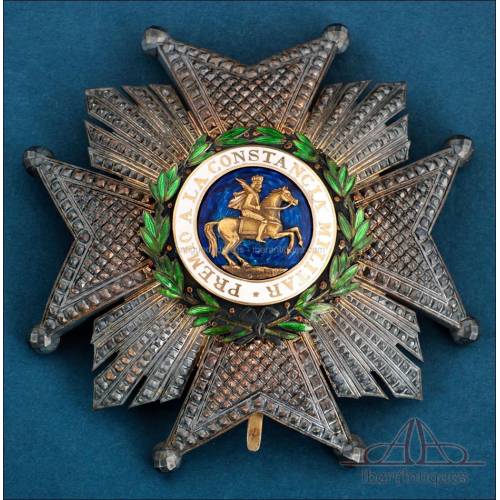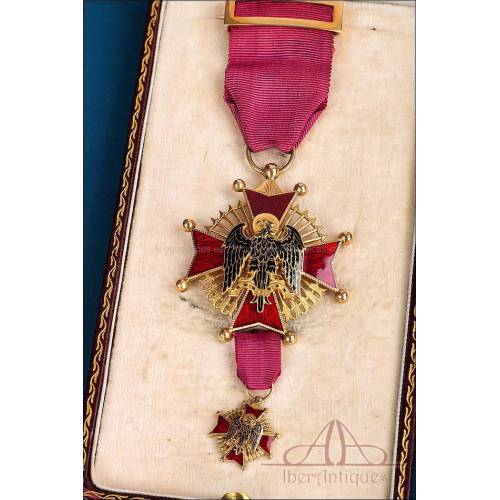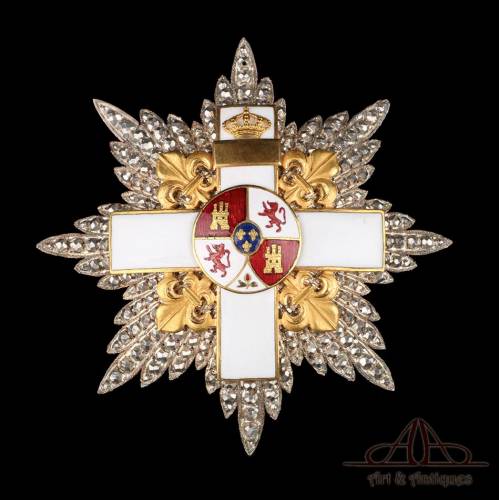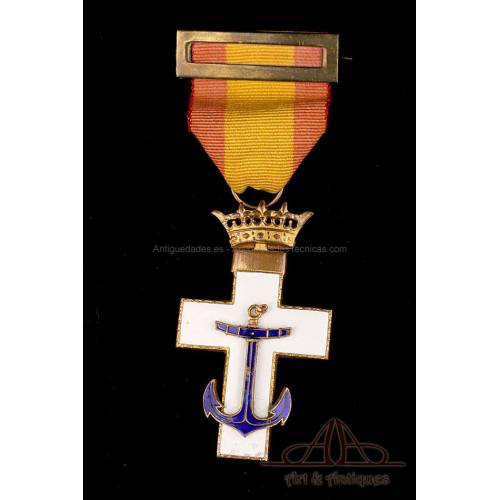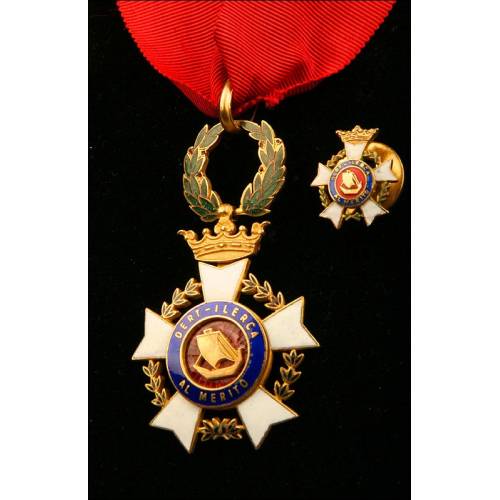Antique Medals and Orders
Under the generic (and certainly incomplete) name of antique medals we usually encompass all kinds of badges and decorations. However, this field is very broad and constitutes a very interesting type of collecting: all these pieces have behind them an interesting history, which is usually crowned by the awarding of the distinction for heroic de...
Under the generic (and certainly incomplete) name of antique medals we usually encompass all kinds of badges and decorations. However, this field is very broad and constitutes a very interesting type of collecting: all these pieces have behind them an interesting history, which is usually crowned by the awarding of the distinction for heroic deeds, distinguished services or victory in competitions or contests. Thus, instead of calling them "antique medals" it is better to use the term "antique decorations". These include pieces awarded by military or civilian institutions, public or private.
Within the distinctions awarded for distinguished service, the truth is that the terms "decoration", "order" and "medal" are often used interchangeably. However, there are important differences that a good collector should be aware of. The orders are military and their delivery implies the entry of the awardee in a corporate entity. The decorations, on the other hand, can be civilian and do not imply membership in any entity. Within the decorations we find different types, from lesser to greater relevance: Medal, Knight's Cross, Officer's Cross, Commendation, Commander, Badge, Grand Cross and Collar. Thus, the medal would simply be a type of decoration. On the other hand, badges, pins and medals can also be of a sporting, artistic, decorative, etc. type. In fact, badges and pins are often used to indicate that the wearer belongs to some type of organization, club or similar. This is the example of the badges of soccer clubs, of political organizations (for example, the quoted old badges of the FE de las JONS of Franco's era or of the German SS)...
Brief history of antique decorations.
Ancient decorations have their origin in Egypt. Their direct ancestor are the gold necklaces that pharaohs gave to their subjects to reward extraordinary services. During classical times, the Greek civilization had a decoration known as taphalara, circular in shape and intended for soldiers who stood out for their heroism. Similar to it was the Roman phalera, which instead of being placed on the horse's harness (as the Greeks did) was placed on the soldier's breastplate. During the Middle Ages the most important ancient decorations were the military orders, among which are some as famous as the Order of the Temple or the Order of Calatrava. From the 17th century onwards the decorations entered the Modern Era, which began in France with the Military Order of Saint Louis created by Louis XIV. The hierarchy of this Order, with the degrees of Knight, Commander, Grand Cross and Pension, was continued by those that came later and also by those of other countries. In the 19th century it was established that the orders were awarded to all military ranks equally, according to their merits. During the twentieth century and up to the present day governments around the world continue to award decorations to civilians, military and institutions or figures from all walks of life.
Brief history of ancient medals.
Formerly, the medals were circular in shape and were minted on both sides. Over time the shape has varied and there are different types. We can find purely artistic medals, commemorative (as a souvenir to some special event), awarded by an organization for distinguished services given as a prize of a contest or competition, religious type or awarded by the government for services to the country (both civilian and military type). The term "medal" appears for the first time written in Tuscan texts dating back to the 13th century. Apparently, the first medals as such were minted during the time of Emperor Augustus (1st century B.C.), after which they fell into disuse and their manufacture became more rudimentary. In the Renaissance (15th century), the figure of Vittore Pisano Pisanello is instrumental in the revival of modern medals as we know them today. Pisanello recovered Roman minting techniques and improved them by carving the medals struck with a burin. In later centuries, great artists such as Albrecht Dürer created commemorative and artistic medals for commissions from individuals or institutions. Medals may or may not be decorations: such qualification depends on whether they have been awarded by the government or some civil or military institution as a reward for certain services, or for having won in a competition or contest.
Antique medals and antique commemoratives create fantastic collections with thousands of stories to tell and investigate. Their precious designs, colors and the noble materials from which they are made often turn them into real jewels, worthy of historical museums.
Antique Order of Military Merit Medal, Spain, Provisional Government 1868-1871 Antique Order of Military Merit...
Order of Military Merit Medal, 1st Class, white badge. An emblematic piece from Spains monarchical transition. Order of Military Merit Medal, 1st...
290,00 €Knight's Cross of Military Merit, Red Distinction. Era of Alfonso XIII, Spain Knight's Cross of Military...
Knight's Cross of the Order of Military Merit, red distinction for wartime actions, Spain, era of Alfonso XIII. Knight's Cross of the Order of...
SoldOrder of Mª Isabel Luisa, Decoration of Isabel II (1839-1868), Spain Order of Mª Isabel Luisa,...
Cross of the Order of María Isabel Luisa. Commemorating military valor during the reign of Isabel II. (1839-1868) Cross of the Order of María Isabel...
395,00 €Antique Knights Cross of the Order of Carlos III, Era of Alfonso XII-XIII, Spain Antique Knights Cross of the...
Knights Cross of the Order of Carlos III of Spain, from the era of Alfonso XII or XIII, a historical piece in good condition. Knights Cross of the Order of Carlos...
295,00 €Order of San Hermenegildo Badge. J. Medina. Spain, Era of Alfonso XIII Order of San Hermenegildo Badge....
Order of San Hermenegildo badge from the era of Alfonso XIII, manufactured by the house of Juan Medina, Barcelona and Madrid. Order of San Hermenegildo badge from...
SoldOrder of Cisneros in 18K Gold with Miniature, 1960-1975 Order of Cisneros in 18K Gold...
Order of Cisneros badge in 18K gold, with miniature and original case, Spain, 1960-1975. Order of Cisneros badge in 18K gold,...
2 400,00 €Order of Military Merit White Distinctive. Castells. Spain, Alphonse 13th, Circa 1915 Order of Military Merit White...
Superb Plate to the Military Merit White Distinctive in its storing case. Made by Castells. In very good condition. Superb Plate to the Military Merit...
SoldNaval Merit Cross Medal with White Distinction. 2nd Class. Franco era Naval Merit Cross Medal with...
Authentic Naval Merit Cross Medal with White Distinction. In fine condition Authentic Naval Merit Cross Medal...
85,00 € 100,00 €Spain, Order of Dert-Ilerca. Decoration formed by Collar Cross and Miniature. 1960's. Spain, Order of Dert-Ilerca....
Precious decoration, Dert-Ilerca Distinction for Merit Pro Arte. Cross and Miniature. 1960's. Order of Military Merit. Precious decoration, Dert-Ilerca...
250,00 € 417,00 €
New products
-

Antique ivory and silver plated stethoscope, late 19th century
Antique stethoscope from the late 19th century in silver-plated metal...
-

Vintage pendant with shell cameo of Jesús del Gran Poder, carved c. 1970
Vintage pendant with a shell-carved cameo of Jesus del Gran Poder, circa...
-

Antique Roman Style Gilded Silver Chalice with Paten. France, 1932
Antique Roman-style chalice in gilded silver with paten. France, 1932....
-

Beautiful Antique 18 K Gold Ring with 7 Natural Diamonds
Antique 18K gold ring with 7 natural diamonds. Delicate openwork design,...
-

Antique Silver Reliquary. José Vilaplana. Valencia, Spain. Circa 1920
Impressive repoussé silver reliquary by José Vilaplana, Valencia, c....
-

Vintage 18K Gold Ring with 7 Natural Diamonds
Vintage 18K gold ring with seven natural diamonds in floral setting....
-

Antique Silver Chalice. Enameled Crosses. Valencia, Spain, 1942
Spanish chalice from 1942 in solid silver, gifted by the Church of...
-

Antique Silver Chalice and Paten. Granada Spain, circa 1900
Spanish chalice in white silver with matching paten, handcrafted....
Specials
-

Antique Silver Chalice with Gilded Interior, Córdoba, 1889
Antique 1889 Spanish silver chalice...

